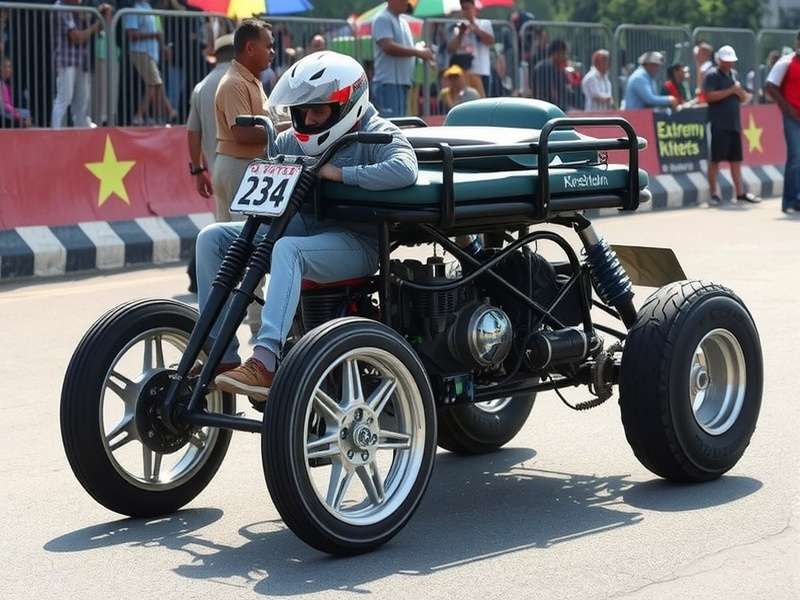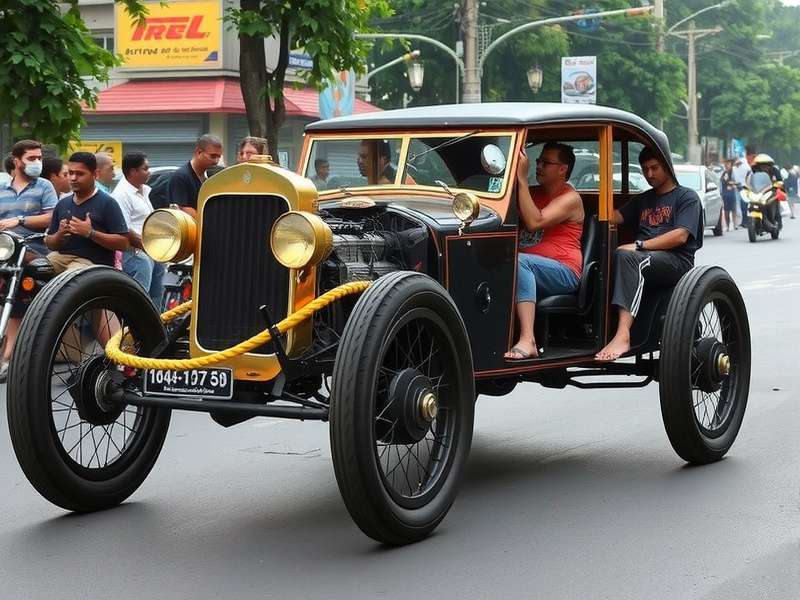Quick Navigation
Key Facts
Overview of Extreme Wheel Challenge
TheExtreme Wheel Challengerepresents the pinnacle of motorsport entertainment in India, combining high-speed racing with spectacular stunt performances. This unique competition has revolutionized how Indians perceive automotive sports, bringing international-level production values to regional circuits.
Unlike traditional racing formats, theExtreme Wheel Challengeemphasizes vehicle control under extreme conditions. Drivers must demonstrate mastery over their machines while executing complex sequences that test both mental fortitude and physical skill.
The competition's appeal lies in its accessibility - while featuring world-class talent, theExtreme Wheel Challengemaintains strong connections with local automotive communities, providing platforms for emerging drivers to showcase their skills alongside established professionals.
Historical Development
The origins ofExtreme Wheel Challengetrace back to underground automotive gatherings in Mumbai during the early 2000s, where enthusiasts would test their skills in abandoned industrial areas. What began as informal competitions soon attracted larger audiences and media attention.

Recognizing the potential for a structured competition, automotive promoters partnered with experienced drivers to create the first officialExtreme Wheel Challengetournament in 2008. This inaugural event featured 12 competitors and attracted approximately 3,000 live spectators.
Evolution and Growth
Between 2013 and 2019, theExtreme Wheel Challengeexperienced exponential growth, expanding from 3 annual events to a 12-event national calendar. This period saw the introduction of specialized vehicle categories, corporate sponsorship, and international competitor participation.
2008 - Inaugural Season
First official competition held in Mumbai with 12 participants and basic obstacle courses.
2011 - Regional Expansion
Events introduced in Delhi and Bangalore, establishing the competition as a multi-city phenomenon.
2014 - Television Broadcast
First national television deal signed, bringing theExtreme Wheel Challengeto 15 million households.
2017 - International Recognition
First international competitors invited, raising the competition's global profile.
2020 - Digital Transformation
During pandemic restrictions, theExtreme Wheel Challengepioneered virtual events and streaming, maintaining audience engagement.
The resilience demonstrated during challenging periods has cemented theExtreme Wheel Challengeas not just a sporting competition, but as a cultural institution within India's automotive community.
Competition Format and Rules
TheExtreme Wheel Challengeemploys a sophisticated scoring system that evaluates competitors across multiple dimensions. Unlike traditional racing where finishing position alone determines success, this format rewards technical precision, creativity, and crowd engagement.
Judging Criteria
- Technical Execution40%
- Style and Originality25%
- Course Completion Time20%
- Crowd Response15%
Competition Structure
- Qualifying Rounds (Time Trials)
- Head-to-Head Elimination
- Freestyle Showcase
- Grand Finale Championship
Each event in theExtreme Wheel Challengecalendar features unique course designs that incorporate local elements and challenges. Course architects work months in advance to create layouts that test different aspects of vehicle control while ensuring spectator safety.
ModernExtreme Wheel Challengecourses typically include 12-18 distinct obstacles that competitors must navigate within a 5-minute time limit. The sequential nature of these challenges creates dramatic tension as drivers attempt increasingly difficult maneuvers while managing their remaining time.
Vehicles and Technology
The vehicles used inExtreme Wheel Challengerepresent the cutting edge of automotive customization, blending performance enhancements with specialized modifications for precision driving. While competitors have considerable freedom in vehicle preparation, all must adhere to strict safety standards.

Most competitors in theExtreme Wheel Challengeutilize rear-wheel-drive platforms with extensive suspension modifications, hydraulic handbrakes, and limited-slip differentials. Engine power typically ranges from 300 to 600 horsepower, balanced against vehicle weight and handling characteristics.
Vehicle Categories
Pro Modified
Heavily customized vehicles with tube-frame chassis and racing engines. Maximum technological freedom within safety parameters.
Street Class
Production-based vehicles with modifications limited to suspension, brakes, and safety equipment. Must remain street-legal.
Veteran Division
Classic vehicles manufactured before 1990, celebrating automotive heritage while competing in modern challenges.
Technological innovation has become a hallmark of theExtreme Wheel Challenge, with teams constantly developing new approaches to vehicle dynamics, tire technology, and driver assistance systems. This technological arms race has produced advancements that eventually filter down to consumer automotive applications.
Notable Champions and Legends
Throughout its history, theExtreme Wheel Challengehas produced legendary competitors whose skills and personalities have shaped the sport's development. These champions have become household names, inspiring new generations of drivers to pursue precision driving excellence.
Rohan "The Maestro" Desai
4-Time Champion (2014, 2016, 2018, 2020)
Renowned for technical precision and innovative maneuver sequences. Holds record for most consecutive podium finishes (17).
Priya "Iron Will" Sharma
3-Time Champion (2017, 2019, 2021)
Pioneering female champion known for aggressive style and consistency under pressure. First driver to win back-to-back championships twice.
Vikram "The Professor" Patel
2-Time Champion (2012, 2015)
Technical master who revolutionized vehicle setup strategies. His analytical approach to course navigation became the standard for future competitors.
Arjun "Showstopper" Singh
Champion (2013)
Flamboyant driver known for crowd-pleasing style and dramatic last-minute victories. His rivalry with Vikram Patel defined the 2012-2015 era.
The legacy of these champions extends beyond their trophy collections. Each has contributed to the technical and cultural development of theExtreme Wheel Challenge, introducing new techniques, training methods, and competitive approaches that have elevated the entire sport.
Safety Protocols and Measures
As theExtreme Wheel Challengehas evolved, so too have its safety standards. What began with basic precautions has developed into a comprehensive safety ecosystem involving vehicle regulations, course design principles, emergency response protocols, and competitor training requirements.
All competition vehicles must undergo rigorous technical inspection before each event, with particular attention paid to roll cage integrity, fuel system safety, fire suppression systems, and driver restraint systems. Vehicles that fail inspection cannot compete until all issues are resolved.
Safety Infrastructure
Course Design
All obstacles designed with runoff areas, impact absorption zones, and multiple escape routes. Digital simulations used to identify potential hazards before construction.
Emergency Response
Dedicated medical teams stationed around course with specialized extraction equipment. Multiple ambulances and medical facilities on standby during all competition sessions.
Driver Safety
Competitors required to use FIA-approved safety equipment including helmets, fire-resistant suits, head and neck support devices, and multi-point harness systems.
The commitment to safety has been instrumental in theExtreme Wheel Challengemaintaining its license to operate in major urban centers. By demonstrating responsible event management, the organization has built trust with local authorities and communities.
Cultural and Economic Impact
TheExtreme Wheel Challengehas transcended its status as a sporting competition to become a significant cultural phenomenon in India. Its influence extends across automotive culture, youth engagement, regional tourism, and technical education.
EachExtreme Wheel Challengeevent generates substantial economic activity in host cities, with hotels, restaurants, and local businesses benefiting from the influx of spectators, teams, and media. Economic impact studies have shown that major events can generate between $5-10 million in direct spending.
The competition has played a pivotal role in changing perceptions about motorsports in India, demonstrating that automotive excellence exists within the country rather than being solely an imported concept. This has inspired greater participation at grassroots levels and increased investment in domestic automotive talent development.
Media Presence and Digital Engagement
With the transition to digital media, theExtreme Wheel Challengehas maintained relevance through strategic content distribution across multiple platforms. Highlights packages regularly achieve millions of views on YouTube, while behind-the-scenes content on Instagram and Facebook provides fans with unprecedented access to their favorite drivers.
The organization's embrace of emerging technologies includes virtual reality experiences, interactive live streams, and esports integrations that allow fans to simulate competition conditions. This multi-platform approach has proven particularly effective at engaging younger demographics who consume media differently than traditional television audiences.
Future Prospects and Developments
As theExtreme Wheel Challengelooks toward its next decade, several strategic initiatives aim to secure its long-term sustainability while expanding its global footprint. These developments reflect both changing audience expectations and evolving automotive technologies.
The integration of electric vehicles represents one of the most significant upcoming changes to theExtreme Wheel Challengeformat. Prototype competitions featuring modified electric vehicles have demonstrated the unique characteristics these platforms bring to precision driving, with instant torque delivery and different weight distribution creating new technical challenges and opportunities.
Technological integration will continue to enhance both the competitor and spectator experiences. Advanced telemetry systems will provide real-time performance data to audiences, while augmented reality applications will offer new ways to visualize vehicle dynamics and course navigation strategies.
Sustainability initiatives are becoming increasingly important, with theExtreme Wheel Challengeorganization committing to carbon-neutral events by 2025. This involves transitioning to renewable energy sources for event operations, implementing comprehensive recycling programs, and offsetting emissions through verified environmental projects.
As automotive technology continues to evolve, theExtreme Wheel Challengeremains committed to its core mission: celebrating driver skill and vehicle control in their most spectacular forms. The competition's adaptability has been its greatest strength throughout its history, and this characteristic will guide its development in the years ahead.
